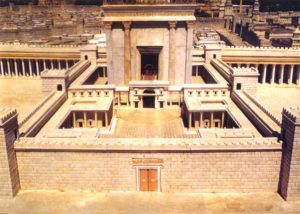The Three Questions
Matthew 24:1-3; Mark 13:1-4; Luke 21:5-7
Late in the afternoon
on Wednesday the thirteenth of Nisan
Our Lord had just left the Temple in judgment, saying: Look, God is abandoning your house to you, leaving it desolate (Matthew 23:38 CJB). ADONAI was not announcing the destruction of the personal homes of the Torah-teachers and the Pharisees, but upon the great house of Jerusalem, the Holy Temple. Jesus and His apostles then left the Temple Mount and crossed back across the Kidron Valley and slowly climbed the Mount of Olives going back to Bethany for the evening. From the Temple Mount to the western base of the Mount of Olives, it was not more than 200 yards straight across, though, of course, the distance to the summit was much greater – about half a mile away.1319 They were on their way to the house of Simon, a leper (whom Jesus had healed). Simon had invited Yeshua to a dinner in His honor (to see link click Kb – Jesus Anointed at Bethany).

A sudden turn in the road and the Sacred Building was once more in full view. From where they paused, they could see over the closed Beautiful Gate, and right to the entrance of the Holy Place, glittering with gold. It was Wednesday, the thirteenth of Nisan (see Ix – The Examination of the Lamb) in the late afternoon, just then the western sun was pouring its golden beams of light on the roof of the Holy Place. It was glorious. The Temple renovation had been underway for about 50 years but would not be completed until 64 AD. By all accounts, it was one of the most splendid and impressive projects in the ancient world. The rabbis said that “He who has not seen the Temple of Herod has never seen a beautiful building (b. B. Bat. 4a; b. Sukkah 41b).
Across the black valley and up the slopes of Olivet, lay the dark shadows of the enormous walls built of massive stones (called Herodian stones), some nearly twenty to forty feet long and weighing more than one hundred tons. The Beautiful Gate itself was made of dazzling Corinthian brass, most richly ornamented; and so massive were its double doors that it needed the united strength of twenty men to open and close them. It was probable as the Twelve gazed on such grandeur and strength that they thought of the gloomy picture of Jerusalem that the Lord had just predicted (Matthew 23:37-39).1320
The contrast between what they saw before them and the desolation that Jesus had just predicted probably shocked them.The apostles’ thought to themselves, how could this be? In silence they pursued their way up the Mount of Olives and Jesus sat down. A week that began at that very spot with Messiah weeping while sitting on a colt then found Him reflective. As they were sitting there together directly across from the Temple, one of the talmidim called His attention to it, saying: Look, Rabbi, what massive stones! What magnificent buildings with gifts dedicated to God (Matthew 24:1; Mark 13:1; Luke 21:5).
Before the destruction of the First Temple, Jeremiah had famously prophesied: For God said: For at the completion of seventy years of Babylon I will remember you, and I will fulfill My good word toward you, to restore you to this place (Jeremiah 29:10). And indeed, that is what happened. A little more than fifty years after the destruction of the First Temple, the Babylonians, who had destroyed it, were vanquished by the rising Persian Empire. The Persian king, Cyrus the Great, soon authorized the Jews to rebuild the Temple, but construction ground to a halt due to interference by the Samaritans. In 353 BC, exactly seventy years after the destruction of the First Temple, the Jews began building again – at first independently, but King Darius soon ratified their effort. Enough of the Second Temple completed that in 349 BC and under the leadership of Ezra and Nehemiah, the community in Judea became vibrant and secure. The Second Temple era spanned 420 years until this prophecy of Messiah was literally fulfilled in 70 AD.
Do you see all these great buildings? replied Jesus. As for what you see here, the time will come when not one stone will be left on another; every one of them will be thrown down (Matthew 24:2; Mark 13:2; Luke 21:6). This must have seemed incomprehensible. Yet that is exactly what happened. When the Temple was set on fire by orders of the Roman general Titus, the gold melted down between the cracks of the Herodian stones. Later, when it cooled down, Titus and his soldiers had to remove stone upon stone to get to the gold that had melted between the cracks of those very stones (see Mt – The Destruction of the Temple in 70 AD). In this way, the prophecy of Yeshua was fulfilled down to the finest detail.
The recent archaeological excavation of the south side of the Temple Mount provides a modern validation of the truth of Yeshua’s word. At that current site lays an impressive pile of stones that once stood on the Temple. This is not to be confused with the retaining wall of the Temple Mount known as the former Wailing Wall, still standing on the west side. Jews continue to gather at the western wall for prayer and celebration, as this is the surviving part of the entire compound but not part of the Temple building itself. Sadly, the magnificent Holy Temple was completely destroyed and literally torn apart by the Romans. There are no coincidences in God’s world. The events of 70 AD would be a sign from ADONAI to that unbelieving generation and to the Jews and Gentiles to this very day. It is another strong proof that Jesus is the true Meshiach of Isra’el.1321

Whether or not the others had gone farther up ahead, or simply that Peter, James, John and Andrew came to Him privately (Mark 13:3), they asked Him what must have weighed so heavily on their hearts; not in doubt, but rather trying to understand. They asked three questions. But the Master teacher did not answer them in order. Because of what Jesus had just said about the Temple, the talmidim asked three questions: (1) When would the Temple be destroyed and what will be the sign that this is about to happen? (2) What will be the sign that the messianic Kingdom will be set up? And (3) what will be the sign that the end of the age has begun? To the Gentile mind the apostles asked three questions, but to the Jewish mind they only asked one question. Having read TaNaKh they believed that the Messiah’s coming would terminate the present age and initiate the age to come (or the messianic Kingdom).
“Tell us,” they said, “when will this (1) happen, and (2) what will be the sign of your coming and (3) of the end of the age” (Matthew 24:3b)?
“Tell us, when will these things (1) happen? And what will be the sign that they (2 and 3) are all about to be fulfilled” (Mark 13:4)?
“Rabbi,” they asked, “when will these things (1) happen? And what will be the sign that they (2 and 3) are about to take place” (Luke 21:7)?
Jesus answered all three questions, but not in the same order as they were asked. He answered the third question first, the first question second and the second question last.1322
It is important to remember that these near historical prophecies like the Dispensation of Grace, and far eschatological prophecies like the Great Tribulation and Second Coming were a mystery to the apostles. Obviously being confusing to them at the time, the talmidim would eventually understand these prophecies with the indwelling of the Ruach Ha’Kodesh. Therefore, the words that Yeshua spoke were for their benefit later on and for us today.



Leave A Comment